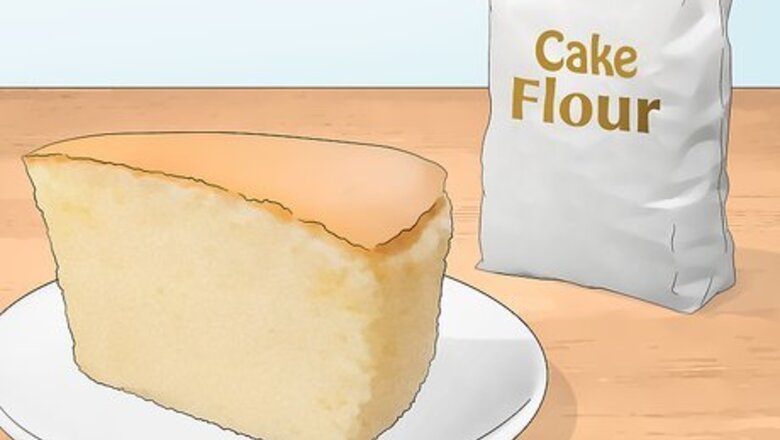
views
Substituting Cake Flour by Volume
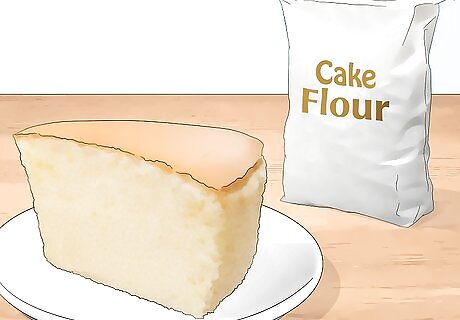
Use cake flour for lighter, fluffier cakes and baked goods. If you want your baked treats to have an airier structure and less-dense consistency, substitute the all-purpose flour for cake flour in a recipe. It has a lower protein content than traditional all-purpose flour, which helps it create a fluffy treat. If you’re baking bread, stick with all-purpose flour or bread flour. Those recipes need the extra gluten for the right consistency. Though cake flour has less gluten than all-purpose flour, it’s still not gluten-free.Substituting Cake Flour: The next time one of these types of recipes calls for all-purpose flour, consider using cake flour instead to see how the texture changes: scones, biscuits, cupcakes, muffins, cakes, pancakes, waffles, and sweetbreads.
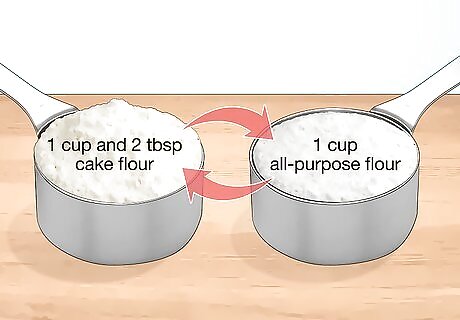
Swap 1 cup and 2 tbsp (128 grams) of cake flour for each cup (128 grams) of all-purpose flour. Because all-purpose flour is denser than cake flour, you have to use a little extra cake flour to make up the total volume called for in the recipe. You could try remembering this equivalency with a little rhyme like, “For an extra-fluffy cake, add 2 tablespoons to the bake!”
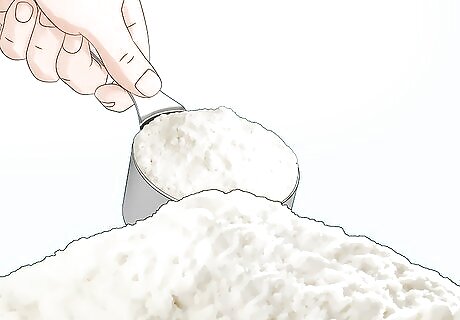
Spoon cake flour into a measuring cup until it’s full and slightly mounded. If you were to dip the measuring cup directly into the container of cake flour to scoop it out, it would get packed down and you’d end up using too much flour in your recipe. Instead, use a big spoon to transfer the flour from the container into the measuring cup. Stop once there is a small mound of flour rising over the rim of the measuring cup. Accurately measuring flour is a really important part of baking. Too much flour in a recipe, and it will be dry and crumbly; too little flour, and the consistency of the baked good will be flat and greasy.
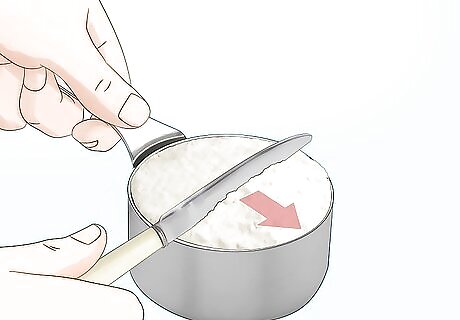
Level the flour in the measuring cup with the back of a butter knife. Take a clean knife and run the straight back of it along the rim of the measuring cup. Push the excess flour back into its container so it doesn’t go to waste. If there is excess flour sticking to the outside of the measuring cup, try tapping the knife against the container to knock it off.
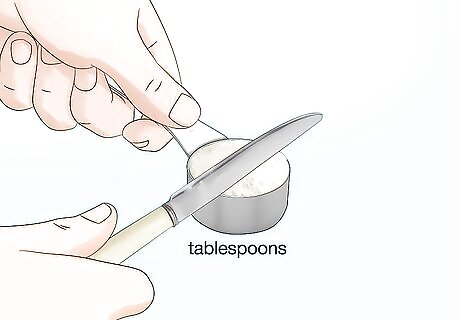
Repeat the measuring and leveling steps for the tablespoons of cake flour. For the tablespoons, you can either scoop flour into them or just use them directly in the container of cake flour. Use the back of your butter knife to level them off before adding them to your recipe.
Using a Kitchen Scale to Weigh Cake Flour

Opt to use a kitchen scale for a more precise measuring of ingredients. If you want to avoid the risk of too tightly or lightly packing a measuring cup with flour, use a kitchen scale. They give exact measurements, making it easy to ensure your ingredients are perfectly weighed. Kitchen scales are also great if you bake a lot of European recipes. Instead of having to convert grams and milliliters to cups, you can just toss your ingredients on the scale and keep baking.
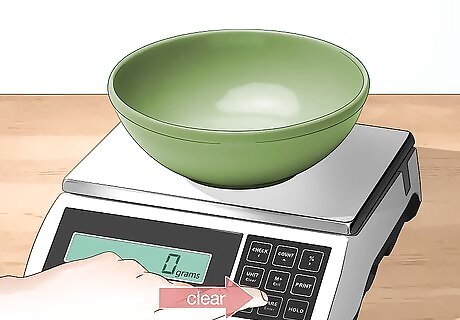
Place a clean bowl on your kitchen scale and zero it out. Most scales have an “on” or “clear” button that you hold down to reset the measurements. Make sure it reads “0” before moving on to measuring out your cake flour. You definitely want to use a bowl of some sort to hold your flour. Putting the flour directly onto the scale will result in a powdery mess, plus you’ll have to clean your scale afterward.

Measure 128 grams (1 cup and 2 tbsp) of cake flour for each cup (128 grams) of all-purpose flour. Use a large spoon to add scoops of flour to the bowl on your kitchen scale. Continue adding flour until the scale reads “128 grams.” If your recipe lists ingredients in grams and milliliters, you’ll simply sub cake flour for all-purpose flour and measure out how many grams are called for. If the recipe lists ingredients in cups, you’ll need to remember that 1 cup of all-purpose flour equals 128 grams.
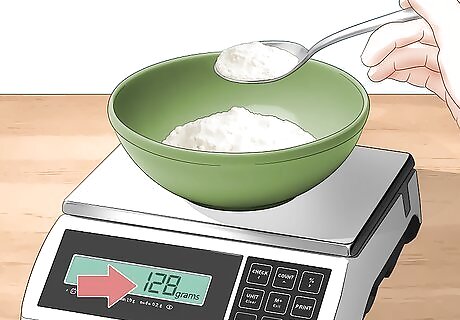
Use a spoon to remove any excess flour until the scale reads 128 grams. If you overfill the bowl with flour, it’s super simple to adjust the measurement until it’s exact. Replace the flour in its container so it doesn’t go to waste. If you have to add other ingredients to the cake flour, just zero out the scale and measure them directly into the same bowl.
Converting All-Purpose Flour to Cake Flour
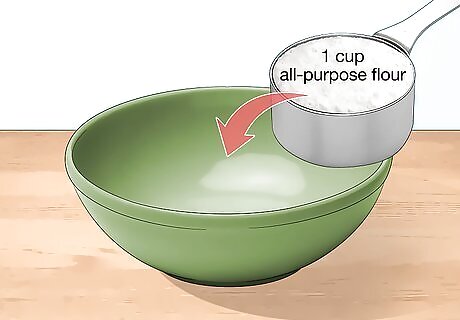
Measure 1 even cup (128 grams) of all-purpose flour into a small bowl. Spoon the flour into the measuring cup, and then level it off by scraping the flat-side of a butter knife along the rim of the cup. Then, carefully dump the measured flour into a small, clean bowl. Make sure your measuring cup is dry before using it. If it’s wet, the flour will stick to the inside of the cup and mess up your measurements.
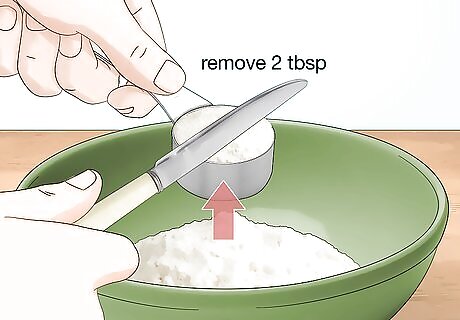
Remove 2 tbsp (17 grams) of all-purpose flour from the bowl. Scoop up each tablespoon and level it off with the back of the butter knife. Put the 2 tbsp (17 grams) back into the container of all-purpose flour—you don’t need to use them but they don’t need to be thrown away. Using accurate measurements is really important in producing a high-quality baked good.

Replace the removed flour with 2 tablespoon (29.6 ml) (15 grams) of cornstarch. Measure the cornstarch and add it to the bowl with the flour. For each cup (128 grams) of all-purpose flour that your recipe calls for, you’ll need to replace 2 tbsp (17 grams) of it with 2 tablespoon (29.6 ml) (15 grams) of cornstarch. If a recipe calls for 1/2 cup (64 grams) of all-purpose flour, you’ll just remove 1 tbsp (8 grams) and add 1 tablespoon (14.8 ml) (7 grams) of cornstarch. Cornstarch helps inhibit some of the gluten in your recipe, meaning that what comes out of the oven should hopefully be lighter than if you were to just use all-purpose flour.
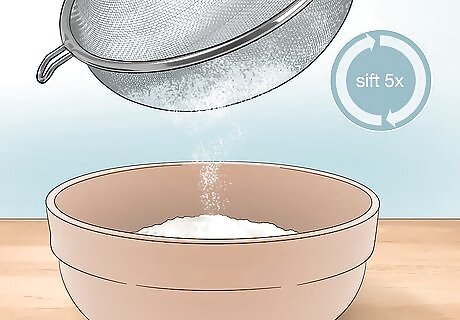
Sift the flour and cornstarch together 5 times. Set a second clean bowl next to the one filled with the flour and cornstarch. Pour the flour mixture into a sifter and gently shake it back and forth over the second bowl until all of it has passed through. Repeat this 4 more times, going back and forth between the 2 bowls to ensure the ingredients are fully mixed. Sifting the flour and cornstarch together is really important in producing a light and fluffy baked good. If the cornstarch isn’t incorporated fully, the consistency of your baked good would be off in areas. If you don’t have a sifter, use a fine-mesh strainer or colander instead.
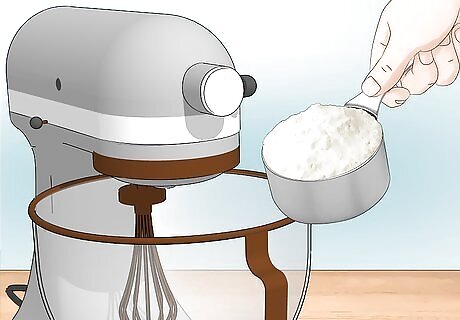
Use the cake-flour substitute in your recipe without other adjustments. Once you’ve subbed out the all-purpose flour for cornstarch, you don’t need to make any other adjustments to your recipe. When your baked good comes out of the oven, it should have a lighter consistency than if you were to have just used all-purpose flour on its own. If you want to test if the cornstarch makes a difference, try baking 2 identical cakes. In one, just use all-purpose flour. In the second one, use the cornstarch substitute. Then, have a taste test to see if you can tell the difference.















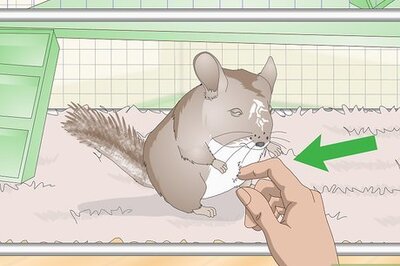


Comments
0 comment